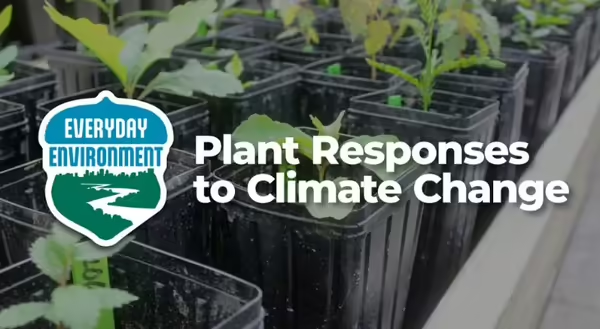
Plants are essential to life on earth. As primary producers, they take energy from the sun and make it available for animals, like humans. So, it makes sense that we care deeply about their future, and how they will respond to the environmental factors of climate change. Let’s explore three aspects of our changing climate that affect plants.
Rising Carbon Dioxide (CO2) Concentrations
The burning of fossil fuels adds large amounts of CO2 into our atmosphere. This may look beneficial for plants at first as CO2 is essential for photosynthesis. This increased carbon dioxide will initially benefit the plant by adding more building blocks to make food for growth. However, that is not the end of the story. Plants are always striving for equilibrium—they need enough food and energy to survive and grow, while also balancing the processes of photosynthesis (making food), transpiration (moving water), and respiration (converting food into energy for growth). Eventually, as sugars build up in the plant through additional photosynthesis, the plant will realize that it doesn’t need to photosynthesize as much to maintain normal growth. This negative feedback loop is called acclimation. Plants will soon become acclimated to the higher atmospheric levels of CO2 and adjust their photosynthetic rate to continue growing at a normal rate.
High levels of CO2 also benefit the water use qualities of some plants. Plants use tiny holes in their leaves, called stomata, to take in carbon dioxide and release oxygen and water. When stomata open to let CO2 in, they let water out in a process called transpiration. With more CO2 in the air, the leaves can take in more CO2 at one time, meaning they do not need to keep their stomata open as often, which leads to reduced water loss. This again, is initially a good thing as water is another essential aspect to photosynthesis but is complicated when coupled with the rising temperatures we expect to see in Illinois.
Rising Temperatures
A basic lesson of chemistry is that added heat, speeds up a reaction. The same is true of photosynthesis. Rising temperatures speed up a plant's food-making process. However, as with all things, there is a limit. Rising temperatures reach a point where the enzymes necessary for photosynthesis break down, leading to a rapid decline in the plant’s ability to survive. While plants can hold onto more water, they then miss out on an important aspect of losing that water: cooling. When water evaporates from the open stomata of a plant, that evaporated also takes heat with it and effectively cools the plant down to survive our hot summer weather.
Altered Water Availability
Illinois is expected to see large amounts of rainfall in a short amount of time, followed by longer periods of drought- conditions that affect how plants function. During drought, plants have techniques for holding onto water. Some plants, like warm season grasses and cacti, have special adaptations that allow them to go months without rain. However, all plants will die if they do not have the sufficient water amount they are evolved to need. A goldilocks effect occurs as well, when looking at the contrast, too much water during times of extreme flooding can cause plants to suffocate due to lack of air.
These stressors on plants can make them more susceptible to disease and pests. A tree that is suffering from drought does not have the resources to put energy into defense for when a pest comes along for a snack.
Looking to the Future
Current research efforts include looking at how to alter photosynthesis to resolve the issue of tissue breakdown at high temperatures. Other areas of research look at organisms that partner with plants such as mycorrhizae and how this partnership can help plants with drought and heat resilience. Researchers are working to gather more information on how to both mitigate climate change and adapt to the reality of those changes.
Thank you for reading!
Everyday Environment is a series of blogs, podcasts, webinars and videos on exploring the intricate web of connections that tie us to the natural world. Check out the podcast episode on this topic to hear more about plant adaptations with Karla Griesbaum.
Subscribe to Everyday Environment Newsletter More about Everyday Environment